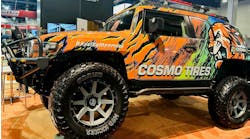We first asked analyst Saul Ludwig to predict the future of the tire industry in our January 1973 “Facts Issue.” At the time, many independent tire dealers and investors were concerned about the growth of radial tires, and the proliferation of sizes.
They also were confused about what was happening in their industry. The federal government was implementing business-altering legislation. States were wrestling with minimum tread-depth laws. And tires were being imported at record levels.
Ludwig was optimistic despite the uncertainty.
“When changes occur in an industry, two things happen,” he said. “First, those who view the change as an opportunity usually come out stronger; and secondly, those who view change with apprehension and uncertainty usually come out as losers.”
Thirty-eight years later, the issues haven’t changed that much. Neither has Ludwig.
Although he left KeyBanc Capital Markets in April to work for Northcoast Research Holdings LLC, he’s still a managing director, still based in Cleveland, Ohio — and still the top analyst in the business.
Ludwig admits he wasn’t optimistic enough last January, when he predicted 2010 domestic replacement and original equipment consumer tire shipments would increase 2.6% and 10%, respectively, compared to 2009.
The final numbers finished closer to 6% and 34%, as demand greatly outpaced supply through the first half of the year.
“Who would have guessed that U.S. auto and light truck sales would have increased 14% in 2010?” he says.
[PAGEBREAK]
MTD: Are the effects of the recession over for tire manufacturers? Tire dealers?
Ludwig: No — for both manufacturers and dealers. Total tire unit shipments in 2010 are estimated to have been 284 million, but that would still be 8% below the former peak of 310 million shipped in 2007.
On the other hand, a recovery is clearly underway, as evidenced by the recent sharp recovery in truck tires. I also think the new tax bill will be a positive.
The key, however, will be unemployment. With unemployment around 10% — and there being no signs of it getting much better anytime soon — the recovery is fragile, in my opinion.
MTD: We estimate that Chinese consumer tire imports to the U.S. will be down nearly 28% compared to 2009. Yet imports were way up. Who picked up the slack?
Ludwig: Chinese consumer tire imports in 2010 were, indeed, down about 30%, but imports from all other countries increased 50%, bringing the total number of imports up about 16%. The biggest increases came from Korea and Indonesia.
MTD: Is the tariff reduction from 39% to 34% — and to 29% next Sept. 26 — enough to significantly increase Chinese imports in 2011?
Ludwig: The tariff for Chinese passenger and light truck tires was reduced 5% last September and will be reduced another 5% in September 2011. For 2011, I expect Chinese imports to increase about 10% even as prices on those tires have been increased due to higher raw material costs.
When the tariff was first imposed, there was great consternation among importers of those tires, and it took a while to make pricing adjustments to justify beginning to import them. Some of the Chinese companies may have reduced their export prices to offset some of the tariff’s impact.
Chinese passenger tires imported in each of the first three quarters of 2010 were as follows: 6.1 million in 1Q10, 6.8 million in 2Q10, and 7.1 million in 3Q10. It seems manufacturers and marketers became a little more comfortable importing Chinese tires as 2010 unfolded.
MTD: What were the U.S. shipment highlights in 2010 vs. 2009 for passenger, light truck and medium truck tires?
Ludwig: What a difference a year makes (see chart on page 22). Replacement and OE shipments were up in every category in 2010. The previous year, they were all down dramatically.
Replacement passenger tire shipments last year broke the 200 million barrier again for the first time since 2007, jumping from 189.5 million units in 2009 to 201 million in 2010. OE units were up 35%, from 24.3 million to 32.8 million.
Light truck tire shipments at the replacement level increased more than 5%, from 27.5 million units to 29 million. At OE, LT shipments were up 28.5%, to 3.6 million units.
In contrast to last year, medium truck tire shipments were up in 2010. Replacement units rose more than 17%, while OE units grew 29%., to 3.1 million.
In 2011, I predict shipments will continue their upward trend. My specific forecasts are as follows: Replacement passenger and light truck tires to grow an additional 2% and 3.6%, respectively. At OE, passenger tire shipments should increase 6.7%, while light truck tire shipments will grow by 7.6%.
This year also will be another great year for replacement and OE truck tire shipments, with each growing by 17%.
[PAGEBREAK]
MTD: Will the change in the political climate in Washington, D.C., have an effect on tire manufacturers? Tire marketers? Tire dealers?
Ludwig: The political climate is unsettling given the inability to get much done, although passage of several bipartisan bills at year end was a welcome change. The resolution of the tax situation was a good thing, so that gives manufacturers and dealers clarity to plan. But in the near future, politics may not have much influence on this industry unless there emerges some success in job creation. Jobs, more or less, will be the biggest influence on the health of the tire industry.
MTD: How did raw material costs in 2010 compare to 2009? How will raw material costs in 2011 compare to 2010?
Ludwig: Raw material costs increased an average of 25% in 2010 compared to 2009. In 2011, I estimate that, on average, raw material costs will rise another 10%. That’s a high number — inflation is normally 3%. Using averages, however, may be misleading. So for greater clarity, I compared prices for raw materials in December 2010 vs. December 2009 to show more dramatically what has occurred. Natural rubber was up 65% and the cost of butadiene rose 50%.
MTD: Who were the market share winners and losers among tire manufacturers in 2010?
Ludwig: The winners were Hankook, Falken, Cooper, Pirelli and non-Chinese imports. Share losers were Chinese imports and Goodyear. Michelin, Conti and Bridgestone held fairly steady.
MTD: What are your top matters of concern or interest to watch out for in 2011?
Ludwig: As raw material costs increase, so will tire prices. You can expect another round of price increases in 1Q11. Will manufacturers be able to pass them on?
Also, how will the consumer cope with ever increasing tire prices?
I think consolidation among tire manufacturers could occur. I expect distributors will continue to consolidate.
Despite tariffs, Chinese consumer tire imports may resume an upward path.
Finally, I expect more plant announcements targeting countries such as Brazil, Indonesia, India, China and Russia. There even will be a new plant in the U.S. if Kumho goes through with its plans to build a plant in Macon, Ga. ■
Defining moments in 2010
Modern Tire Dealer asked Saul Ludwig, a managing director with Northcoast Research Holdings LLC, what the defining moments in the tire industry were in 2010. Here are his answers.
1. “Leadership changes at any large company is always important because you never know if the new person will make substantial changes. So the retirement of Bob Keegan and the appointment of Rich Kramer to CEO at Goodyear and the change from Mark Emkes to Gary Garfield at Bridgestone Americas were important events.”
2. “The surge in raw material costs, including a near doubling of natural rubber prices, was surprising. The demand for natural rubber was up 12%, while natural rubber production may have increased just up to 6%. This necessitated three rounds of price increases by tire manufacturers, putting added pressure on consumers. “
3. “There also was a surge in announcements for new tire plants, to be built in China, Indonesia, India, Mexico and Brazil. By 2015, these plants could add approximately 340 million tires to today’s global capacity of about 1.4 billion tires. Even in the U.S. there have been some modest expansions announced.”
4. Cooper turnaround. “Cooper Tire lost $220 million in 2008; in 2010, it might have had record earnings. This was a remarkable transformation. Cooper benefitted from capacity rationalization, plant efficiencies and the tariffs.”
5. The restructuring of Pirelli. “Pirelli shed virtually all of its non-tire operations to become a pure tire company, and outlined an aggressive global expansion program supported by $2.5 billion in new capital investments.”
6. Long-term planning. “Michelin increased its capital base as it plans to build a new tire plant each year for the next five years, while Hankook, now the 10th largest tire manufacturer in the world, boldly rolled out a plan to become the fifth largest within five years.”
7. OEM success. “Who would have guessed that U.S. auto and light truck sales would have increased 14% in 2010, and that GM would emerge from bankruptcy and successfully go public once again?”




